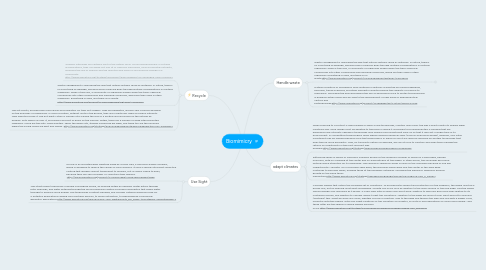Biomimicry
por Maomao Guo


1. Recycle
1.1. "Disease outbreaks are certainly part of the natural cycle. Occurring periodically in virtually all populations, they can weed out less fit or vigorous individuals, recycle essential nutrients, influence the mix of species and the direction and pace of successional change in a community. http://www.asknature.org/strategy/9235e6ea113ad72ed86b51c64fb5ed86#.Uwu2JvRdXeM
1.2. Waste Management is mimicking the way that natural systems reuse all materials. In nature, there's no such thing as garbage, because every molecule goes through multiple configurations in multiple organisms. When a tree falls, a community of organisms breaks down the tree's chemical compounds into other compounds and individual molecules, which are then used in other organisms. Everything is used, and there is no waste. http://www.asknature.org/product/fc4d0678aa5aba1b8195ec177bcaafce
1.3. The ant-plants, provide even more lavish accomodation for their ant-lodgers. They are epiphytes, and are very common growing on the branches of mangroves. In such a position, without roots in the ground, they are in particular need of mineral nutrients. Their guests provide it. The ant-plant's stem is swollen into a globe the size of a football and armoured on the outside by prickles. Ants swarm all over it, scurrying in and out of holes on the surface. Within, there are a number of large interconnected chambers. Some are the ants' living quarters. There the queen sits, steadily producing her eggs, and there too are the nurseries where the young larvae are kept and reared. .http://www.asknature.org/strategy/353225538ceb82da183d6c0938eef61b#.Uwv-mPRdXeM
2. Use Sight
2.1. Ornilux is an insulated glass sheeting made by Arnold Gals, a Germany-based company, which is designed to reduce the causes of bird collisions. It uses a special ultraviolet-reflective coating that appears almost transparent to humans, but is clearly visible to birds, because they can see a broader UV spectrum than humans .http://www.asknature.org/product/077e9d44e8e12f039458729f8de1ada9
2.2. The Strait Power turbine has a double converging nozzle, an opening within an opening. Water enters through both openings, and water entering through the second opening creates a pressure differential that draws water through to produce more energy. The technology is patent-pending, and founder Anthony Reale has filed for 5 potential applications ranging from portable devices, to home installation, to high powered commercial generator applications.http://www.asknature.org/search?query=use+sight&results_per_page=10&category=default&page=4
3. Handle waste
3.1. Waste Management is mimicking the way that natural systems reuse all materials. In nature, there's no such thing as garbage, because every molecule goes through multiple configurations in multiple organisms. When a tree falls, a community of organisms breaks down the tree's chemical compounds into other compounds and individual molecules, which are then used in other organisms. Everything is used, and there is no waste.http://www.asknature.org/product/fc4d0678aa5aba1b8195ec177bcaafce
3.1.1. By using a system based on the human body's kidneys - the ultimate in water recycling technology - Singapore and Orange County, CA have developed schemes that will use a dual membrane process to recycle domestic waste water to levels that approach the quality of distilled water. http://www.asknature.org/strategy/8daa84f58ba5cba82c7bb74d95c4dba8#.Uwul6vRdXeM
